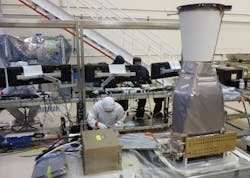Lockheed Martin delivers second focal-plane-array lightning-tracking instrument for NOAA weather satellite
Lockheed Martin (NYSE: LMT; Palo Alto, CA) has delivered the second Geostationary Lightning Mapper (GLM) instrument that will provide earlier alerts of severe storms and contribute to more-accurate tornado warnings. The sensor will fly on the second next-generation Geostationary Operational Environmental Satellite, known as GOES-S, for the U.S. National Oceanic and Atmospheric Administration (NOAA).
The Lockheed Martin team wrapped up the assembly, integration, test, and delivery of the second GLM instrument a mere 13 months after delivery of the first unit.
"We reduced the build and test time of this complex instrument by 40% compared to the first unit," says Jeff Vanden Beukel, Lockheed Martin's GLM program director. "Now that development is complete, we are able to reduce delivery time so the GOES program can serve our nation with more accurate weather information."
A rapid increase of in-cloud lightning can precede severe weather on the ground. GLM tracks that activity and gives faster warning plus more precise location information versus current systems. It does this by tracking lightning flashes at a 70% to 90% flash-detection efficiency from geostationary orbit, with continuous coverage of the United States and most of the Western Hemisphere. (Geostationary orbit is about 36,000 km away from the Earth's surface, in contrast to the International Space Station's low-earth orbit, which is only a few hundred kilometers from Earth.
GEOS is a constellation of satellites; their letter designation changes to a number after launch. For example, the GEOS-N became the GEOS-13 satellite after launch in 2006. The GEOS-S is scheduled for launch in 2017.
Detects oxygen triplet line
The heart of the GLM instrument is a single-band (777.4 nm), high-speed (500 frames per second), 1.8 megapixel (1372 x 1200 pixel) staring CCD focal-plane array (FPA), integrated with low-noise electronics and specialized optics (including narrowband optical filtering, of course) to detect weak lightning signals, even against bright, sunlit cloud backgrounds. The 777.4 nm wavelength corresponds to the the atomic oxygen OI(1) triplet line emitted by lightning flashes. The downlink-to-Earth data rate is 7.7 Mbit/s.
The instrument was developed at Lockheed Martin’s Advanced Technology Center in Palo Alto.
GOES satellites are a key element in NOAA’s National Weather Service operations, providing a continuous stream of weather imagery and sounding data used to support weather forecasting, severe-storm tracking and meteorological research. The GOES program is managed and operated by NOAA, and NASA’s Goddard Space Flight Center manages GLM instrument development. The team is preparing GLM for integration on the GOES-S spacecraft at Lockheed Martin’s facility near Denver.
Sources:
http://www.lockheedmartin.com/us/news/press-releases/2016/january/ssc-011216-GLM-release.html

John Wallace | Senior Technical Editor (1998-2022)
John Wallace was with Laser Focus World for nearly 25 years, retiring in late June 2022. He obtained a bachelor's degree in mechanical engineering and physics at Rutgers University and a master's in optical engineering at the University of Rochester. Before becoming an editor, John worked as an engineer at RCA, Exxon, Eastman Kodak, and GCA Corporation.
